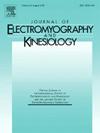The relationship between voluntary and electrically evoked muscle contractile properties in young women
IF 2.3
4区 医学
Q3 NEUROSCIENCES
引用次数: 0
Abstract
Isokinetic dynamometry and neuromuscular electrical stimulation [NMES] are commonly used to assess muscle contractile function, but few studies have investigated the relationship between the two, particularly in women. Thirty young women (age 23 ± 5 y) therefore performed maximal knee extensions on an isokinetic dynamometer at angular velocities of 0.00–6.28 rad/s, after which NMES of the quadriceps was used to determine unpotentiated and potentiated twitch contractile properties as well as the torque-frequency relationship. Voluntary isometric peak torque was correlated with peak torque, absolute rate of torque development, and the absolute rate of relaxation during potentiated twitches (ie, r = 0.557, 0.585, and −0.650, P = 0.00786, 0.00411, and 0.000779, respectively). Voluntary isokinetic peak torques at 1.57 and 3.14 rad/s were also correlated with the potentiated absolute rate of torque development (ie, r = 0.597, P = 0.00309 and r = 0.551, P = 0.00849, respectively). No other significant correlations were found between voluntary and electrically evoked muscle contractile properties, including various measures of the torque-frequency relationship. Although there is some relationship between voluntary and NMES indices of muscle contractility, such results are only moderately well-correlated at best. The two techniques should therefore be considered complementary rather than interchangeable.
年轻女性随意肌和电诱发肌收缩特性之间的关系
等速动力学测量和神经肌肉电刺激[NMES]通常用于评估肌肉收缩功能,但很少有研究调查两者之间的关系,特别是在女性中。因此,30名年轻女性(年龄23±5岁)在角速度为0.00-6.28 rad/s的等速测力仪上进行了最大膝关节伸展,之后使用股四头肌的NMES来确定未增强和增强的抽搐收缩特性以及扭矩-频率关系。自主等长峰值扭矩与峰值扭矩、绝对扭矩发展速率和增强抽搐期间绝对弛豫速率相关(r = 0.557、0.585和- 0.650,P分别= 0.00786、0.00411和0.000779)。自主等速峰值扭矩在1.57和3.14 rad/s时也与增强的绝对扭矩发展速率相关(分别为r = 0.597, P = 0.00309和r = 0.551, P = 0.00849)。在自愿和电诱发的肌肉收缩特性之间没有发现其他显著的相关性,包括扭矩-频率关系的各种测量。尽管自发性和NMES肌肉收缩指数之间存在一定的关系,但这些结果充其量只是适度的良好相关。因此,这两种技术应被认为是互补的,而不是可互换的。
本文章由计算机程序翻译,如有差异,请以英文原文为准。
求助全文
约1分钟内获得全文
求助全文
来源期刊
CiteScore
4.70
自引率
8.00%
发文量
70
审稿时长
74 days
期刊介绍:
Journal of Electromyography & Kinesiology is the primary source for outstanding original articles on the study of human movement from muscle contraction via its motor units and sensory system to integrated motion through mechanical and electrical detection techniques.
As the official publication of the International Society of Electrophysiology and Kinesiology, the journal is dedicated to publishing the best work in all areas of electromyography and kinesiology, including: control of movement, muscle fatigue, muscle and nerve properties, joint biomechanics and electrical stimulation. Applications in rehabilitation, sports & exercise, motion analysis, ergonomics, alternative & complimentary medicine, measures of human performance and technical articles on electromyographic signal processing are welcome.

 求助内容:
求助内容: 应助结果提醒方式:
应助结果提醒方式:


